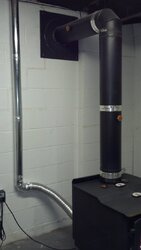I finally came to the conclusion that if the inlet had a T and an inlet from both the front and back of the house fed that T before going to the stove, that it would be difficult for a reverse chimney to happen. So, I'm planning on putting two inlets through the rim board - one in front and one in the back.
Good God, I think you're overthinking this just a teensy bit.
I would just bag the idea of an OAK. They're pretty much pointless, anyway, unless your house is as airtight as the vacuum chamber in a Thermos bottle. (And no house is, or should be.)
Why?
1. If you pull outside air into the stove for combustion, the amount of heat you get out of the stove will be reduced compared to the amount of heat you could get out of the stove if you used "inside" air for combustion air.
2. By how much would that amount of heat be reduced? It would be reduced EXACTLY by the Δt (temperature differential between outside air and inside air) x (number of pounds of air per hour consumed by the stove.)
3. In other words, all other things being equal, in order to get as much heat out of the stove using outside air as inside air, you must FIRST heat the outside air to the same temperature as the inside air. (Hint: That's exactly what happens when air is drawn in through all the cracks and tiny holes in a house to replace the air that goes up the stack.)
4. In other, OTHER words: It's a wash. You'll get no more efficiency from the stove, in terms of how much heat you can extract from it, using outside air as inside air.
5. More importantly, you MAY reduce the COMBUSTION efficiency of the stove by introducing combustion air that is too cold, if you use outside air.
So before you go spending $10K designing NASA rocket-surgery plenums and intake manifolds ... I would advise a dose of common sense...




 ...
...